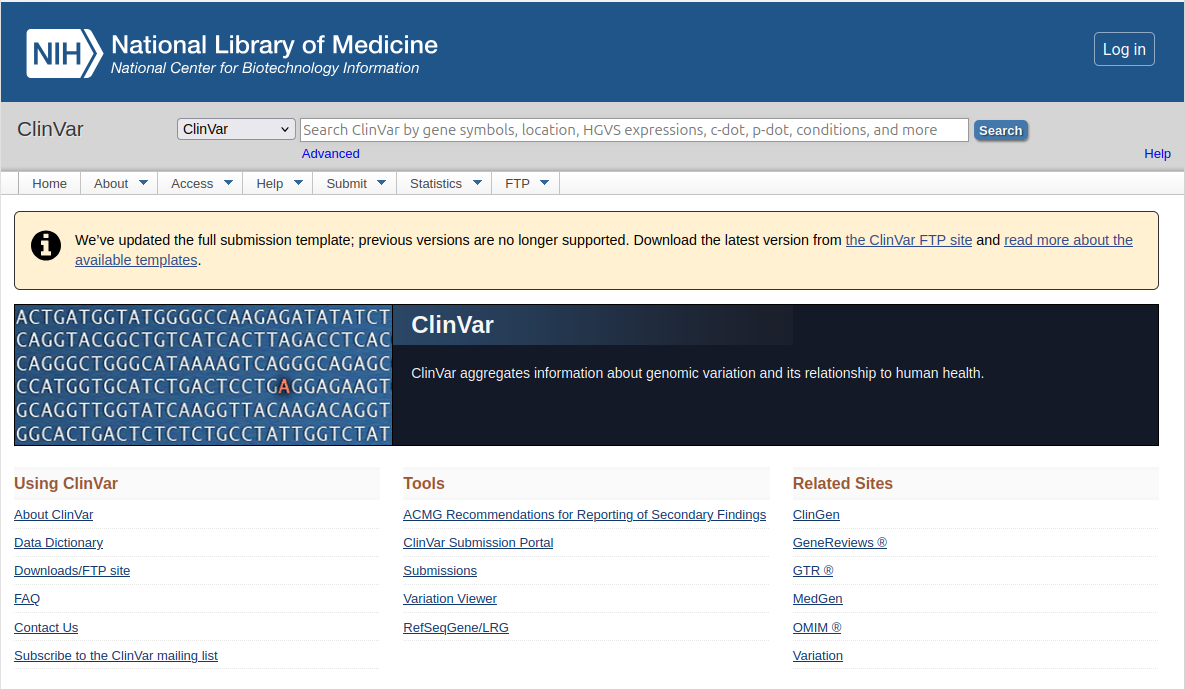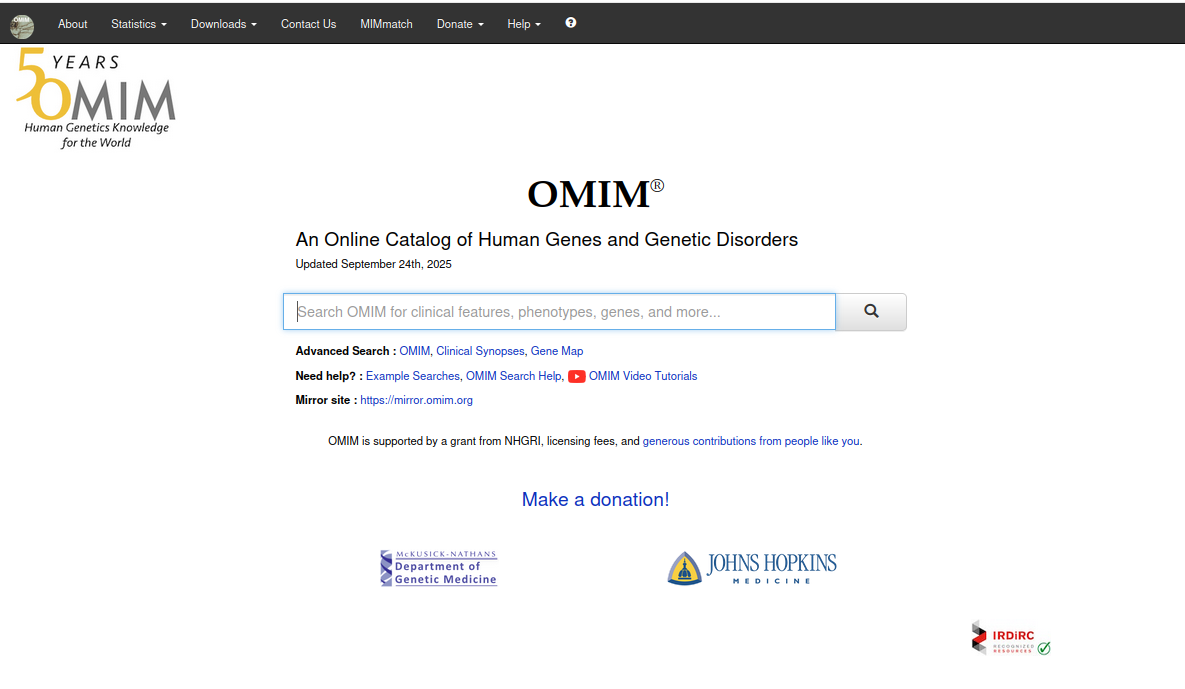Topic 4 | Variants and Diseases
📅 Date: 29/30 September 2025
📖 Synopsis: Exploring databases: ClinVar, OMIM
Lecture topics
- Accessing clinical variant data - ClinVar
- Exploring disease associations and inheritance - OMIM
- Understanding how genetic variation is linked to disease - ClinVar / OMIM
Learning goals
- Learn to retrieve disease-related variant information.
- Explore how clinical resources document genetic associations.
- Relate molecular changes to curated disease knowledge.
Introduction
This class explores two important clinical genetics databases: ClinVar and OMIM.
ClinVar collects and shares information about the clinical significance of genetic variants, while OMIM is a comprehensive catalogue of human genes and genetic disorders.
Together, they help connect specific variants with disease descriptions, providing complementary views on medical genetics.
Challenges
- Complex terminology: clinical significance terms (e.g., pathogenic, likely benign) and disease inheritance patterns may be unfamiliar.
- Variant mapping: linking a genetic variant in ClinVar to the correct OMIM disease entry can be confusing.
- Evidence levels: ClinVar entries vary in strength (single submission vs expert panel review).
- Cross-references: many links lead to other resources (NCBI Gene, UniProt, PubMed), requiring careful navigation.
It’s normal to feel uncertain at first. With practice, you will learn how to interpret the classification systems and follow cross-links effectively.
Databases overview
ClinVar

URL: https://www.ncbi.nlm.nih.gov/clinvar
1. Purpose | Archive of reported genetic variants and their clinical significance for human health.
2. Content | Variant identifiers, genomic coordinates, clinical classification (pathogenic → benign), associated conditions, evidence levels, submitter details, and supporting references.
3. Typical Use Cases
- Look up whether a specific variant has been linked to disease.
- Compare classifications across submitters.
- Find references and links to PubMed, Gene, and OMIM.
4. External Connections | Cross-linked with OMIM (disease descriptions), NCBI Gene/RefSeq, dbSNP, UniProt, and PubMed.
OMIM – Online Mendelian Inheritance in Man

URL: https://www.omim.org
1. Purpose | Authoritative catalogue of human genes and genetic disorders, with curated descriptions of phenotypes and inheritance patterns.
2. Content | Gene–disease associations, inheritance modes (dominant, recessive, etc.), clinical synopses, phenotype series, references, and historical notes.
3. Typical Use Cases
- Find detailed descriptions of diseases linked to a gene.
- Understand inheritance patterns and clinical features.
- Explore curated references to key publications.
4. External Connections | Linked with ClinVar (variants), NCBI Gene, UniProt, PubMed, and pathway resources such as KEGG and Reactome.
TP Activity 4
Imatinib & Chromosomal Fusions
Goal
How to work
Search for imatinib in DrugBank. Briefly review the drug overview.
Navigate to the Pharmacology -> Indication section and identify the diseases or conditions treated with imatinib. Then, go to OMIM and search for chronic myeloid leukemia. Explore the gene–disease relationships, inheritance patterns, and clinical summaries relevant to imatinib’s targets.
In OMIM, explore the Gene/Locus MIM number for both the BCR and ABL1 genes (links are in the Phenotype–Gene Relationships table at the top).
On the MIM page for each gene, find the Variation section under External links in the table on the right. Choose one gene and click the ClinVar link.
In ClinVar, you will find all reported variants for your chosen gene, their clinical significance, and associated conditions. Filter the variants by one type of Germline classification and one type of Molecular consequence that you find most interesting. Explore these in detail.
Notes | About clinical genetics terminology
1. How to read genetic coordinates (chromosomal locations)
The notation
9q34.12is the cytogenetic band that describes a location on a chromosome. Here’s how to read it step by step:9 -> Chromosome number. This gene or variant is on chromosome 9.
q -> Arm of the chromosome.
- p = short arm (petit)
- q = long arm
- So this is on the long arm of chromosome 9.
34.12 -> Band, sub-band, and sub-sub-band number, based on the standard G-banding pattern seen under a microscope.
- 3 -> Region (counted from the centromere outward)
- 4 -> Band within region 3
- .1 -> Sub-band 1
- 2 -> Sub-sub-band 2
2. How to read and interpret variant notation, using the example c.763G>A.
Prefix (
c.)c.= coding DNA reference sequence. This indicates that the numbering is relative to the coding DNA sequence (CDS) of a reference transcript. Other common prefixes:- g. = genomic sequence (genome coordinates)
- m. = mitochondrial DNA sequence
- n. = non-coding DNA reference sequence
- r. = RNA sequence
- p. = protein sequence
Position (
763)- 763 = the nucleotide position within the coding sequence (CDS), counting from the start codon (ATG) as position 1.
- This means the variant affects the 763rd nucleotide in the coding sequence.
Reference Base (
G)- G = the reference (wild-type) nucleotide at this position.
- This is what is expected in the reference transcript.
Variant Base (
A)- A = the alternate (mutant) nucleotide that replaces the reference base.
- In this case, G is substituted by A.
Type of Variant
- Substitution: one base has been changed to another.
- Full interpretation: “At coding DNA position 763, guanine (G) is replaced by adenine (A).”
Examples of Other Notations
c.763delG→ Deletion of G at position 763c.763_764insA→ Insertion of A between positions 763 and 764c.763_765del→ Deletion of bases 763 to 765c.763+1G>T→ Substitution at the first base of the splice donor site (one base after coding position 763, i.e., in the intron)p.Gly255Asp→ Protein-level change (glycine at codon 255 replaced by aspartic acid)
3. Advice | How to quickly learn about unknown or forgotten terminology?
Example: Do you know what GRCh38/hg38 means? It is the version of the human genome assembly.
- To learn more, please ask Perplexity the following question: “Explain briefly the meaning of GRCh38/hg38 in the context of genomics.”
Keep doing the same (using Perplexity or another search engine of your choice) whenever you come across terminology that is unfamiliar to you, or that you would like a quick recap on.
Reminder: These classes are about learning to explore large information resources and making the most of them.
Evaluation
- Select 4 facts from each database (ClinVar and OMIM) that were surprising or new to you.
- For each fact, briefly explain why it was surprising or new.
- Write your findings in a Word document and submit it in the Tutoria before the end of class.